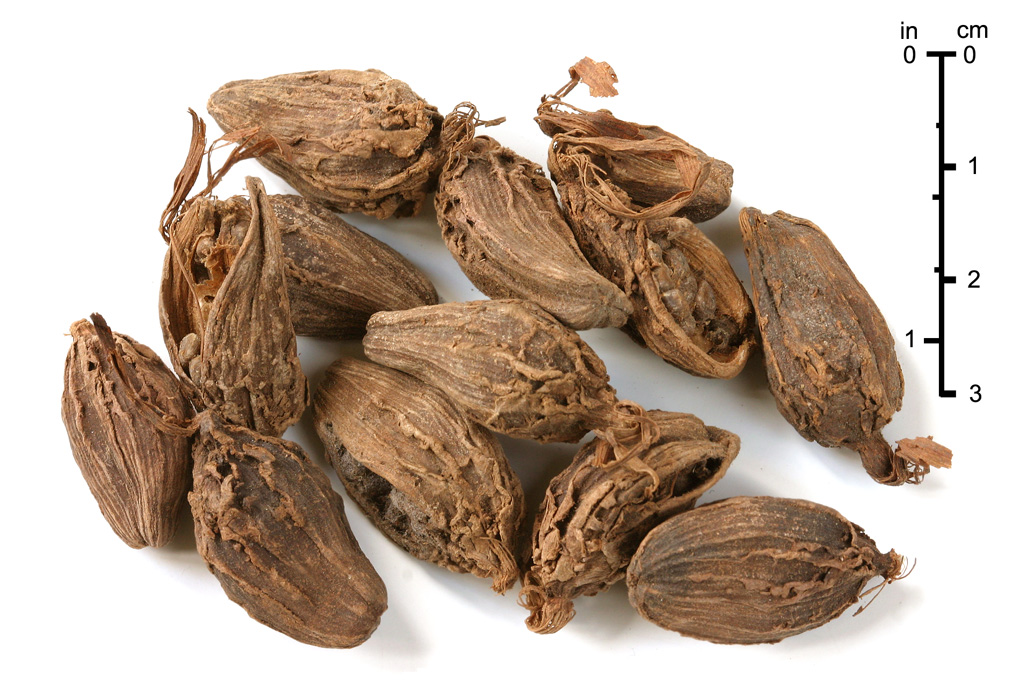Dies ist eine alte Version des Dokuments!
Zingiberaceae - black cardamom, large cardamom, Schwarzer Kardamom, Nepal-Kardamom, Brauner Kardamom
Perennial herb of Nepal, India, Bhutan and China, 1-2m high; leaves oblong-lanceolate, 25-60cm long; flowers yellow.
http://www.efloras.org/florataxon.aspx?flora_id=2&taxon_id=200028341
„The pods are used as a spice, in a similar manner to the green Indian cardamom pods, but with a different flavor. Unlike green cardamom, this spice is rarely used in sweet dishes. Its smoky flavor and aroma derive from traditional methods of drying over open flames.“ http://en.wikipedia.org/wiki/Black_cardamom
„The steam-distilled volatile oil of the large cardamon (Amomum subulatum Roxb.), grown in Sikkim, India, was analysed by GC-MS. It consists of monoterpenic hydrocarbons (16.3%), oxygenated monoterpenes (75.2%) and sesquiterpenes (6.3%). Its major constituents are 1,8-cineole (61.3%), α-terpineol, α- and β-pinene and allo-aromadendrene.“ [Volatile Constituents of Large Cardamom (Amomum subulatum Roxb.). Gurudutt, K. N., Naik, J. P., Srinivas, P. and Ravindranath, B., Flavour Fragr. J., Vol.11 (1), 1996, 7–9]
„Oils obtained by hydrodistillation of the seeds of green, freshly dried and those available in the local market of large cardamom (Amomum subulatum Roxb.) were analyzed by GC and GC/MS. A total of 33 components were identified by mass spectra and relative retention indices. The major component of the oil was 1,8-cineole (81.5–86%).“
[Analysis of the Oil of Large Cardamom (Amomum subulatum Roxb.) growing in Sikkim., Rout, P. K., Sahoo, D., Jena, K. S., Rao, Y. R., Journal of Essential Oil Research, 15(4), 2003, 265-266]
„Physical and chemical quality attributes of authentic regional cultivars (cv) of large cardamom obtained from North,South, East and West regions of Sikkim (India), Bhutan and Nepal were evaluated. The minimum, maximum and mean values for 12 Sikkim samples in respect of the major quality parameters were… volatile oil (2.6, 4.2 and 3.4% v/w)… GC analysis of the volatile oils showed that there was considerable variation among the cultivars with respect to α-pinene (3.2-4.5%), β-pinene (6.7-8.5%), 1,8-cineole (80.4-84.6%), 4-terpineol (0.60-1.30%) and α-terpineol (3.3-4.3%). The oils were similar with respect to specific gravity and refractive index; but optical rotation values varied to some extent.“
[Studies on quality attributes of cultivars of large cardamom (Amomum subulatum Roxb.)., Pura Naik, J., Kumar, M., Sulochanamma, G., Ramesh, B. S., Journal of Food Science and Technology (India), Vol.43(3), 2006, 308-311]

Author: Brian Arthur CC BY-SA 3.0, via Wikimedia Commons
